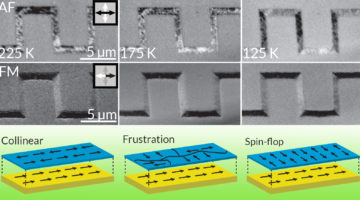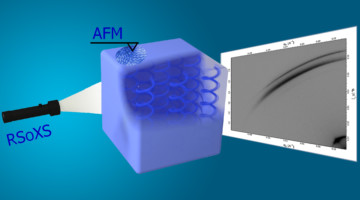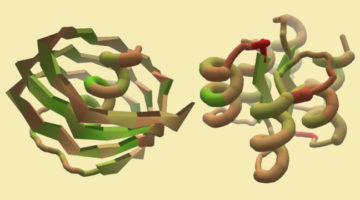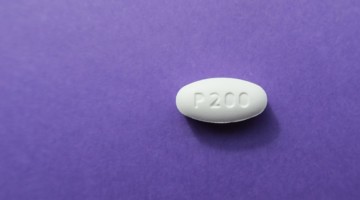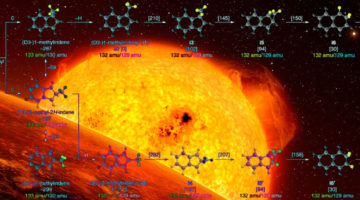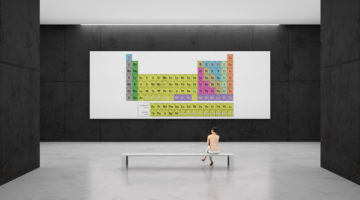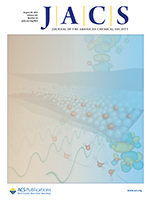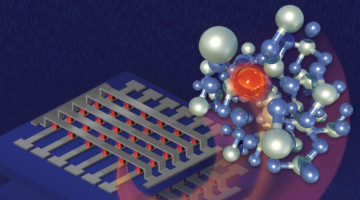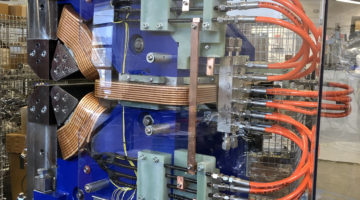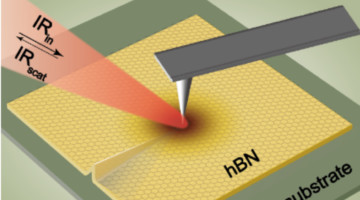Researchers discovered that the spin configuration of a nanostructured antiferromagnetic material can be affected by the dimensions of features imprinted onto the material. The results suggest that nanoscale patterning can be a viable tool for engineering spin configurations in future antiferromagnetic spintronic devices. Read more »![]()
![]()
Multiple Levels of Chirality from Achiral Molecules
Liquid crystal samples were found to exhibit up to four levels of chirality, despite being made up of achiral molecules. The work sheds light on how molecular properties and competing interactions “propagate” order from the molecular level up to the microscale, leading to complexity similar to that found in biological materials. Read more »
A Citizen-Science Computer Game for Protein Design
Using the computer game, “Foldit,” nonexpert citizen scientists designed new proteins whose structures, verified at the ALS, were equivalent in quality to and more structurally diverse than computer-generated designs. The work shows the potential of using crowd-based creativity in the design of new proteins for fighting illness and disease. Read more »![]()
![]()
X-Ray Experiments Contribute to Studies of a Drug Now Approved to Combat Tuberculosis
The U.S. Food and Drug Administration has approved a new antibiotic that, in combination with two existing antibiotics, can tackle one of the most formidable and deadly treatment-resistant forms of the bacterium that causes tuberculosis. Studies exploring the structure and function of the new drug benefited from x-ray experiments at the ALS. Read more »
Study Reveals ‘Radical’ Wrinkle in Forming Complex Carbon Molecules in Space
Scientists have identified several avenues by which ringed molecules known as polycyclic aromatic hydrocarbons can form in space. PAHs—which also occur on Earth in emissions and soot from the combustion of fossil fuels—could provide clues to the formation of life’s chemistry in space as precursors to interstellar nanoparticles. Read more »
The Chemistry of Art
To learn more about the chemical processes involved in aging oil paints in microscopic and nanoscale detail, researchers conducted a range of studies that included 3D x-ray imaging of a paint sample. The study could have broader implications for conservation based on the observed chemistry of oil paints. Read more »
Chemical and Morphological Origins of Improved Ion Conductivity in Perfluoro Ionene Chain Extended Ionomers
Resonant x-ray scattering and x-ray absorption spectroscopy with elemental sensitivity unravel structural features tied to water–ion domains and discern sulfur-containing groups in sulfonated ionomers, which help delineate chemical factors controlling their phase-separated morphology and governing ion transport. Read more »
Microelectronics Town Hall Looks Beyond Moore’s Law
On August 16, Berkeley Lab hosted a town hall on future research and collaboration opportunities in microelectronics—a deceptively simple catchword that encompasses the full range of integrated developments needed to push beyond Moore’s Law. Eli Rotenberg gave one of several short talks about how the ALS fits into this effort. Read more »
Facility News and Shutdown Recap: Summer 2019
It’s been a busy summer at the ALS, with developments ranging from the delivery of a new prototype magnet for testing, to the refurbishing of the Building 80 cubicle farm and lounge area. A five-week shutdown checked off several important upgrades and installations, while other Building 6–related projects proceeded in parallel. Read more »
Infrared Nano-Mapping of Local Strain in 2D Materials
Researchers have demonstrated an infrared technique to map and analyze strain in atomically thin crystals of hexagonal boron nitride (hBN) at the nanoscale. This ultrasensitive strain-imaging method could be a promising tool for the examination of low-dimensional materials of interest for electronic and photonic devices. Read more »
- « Previous Page
- 1
- …
- 50
- 51
- 52
- 53
- 54
- …
- 83
- Next Page »
